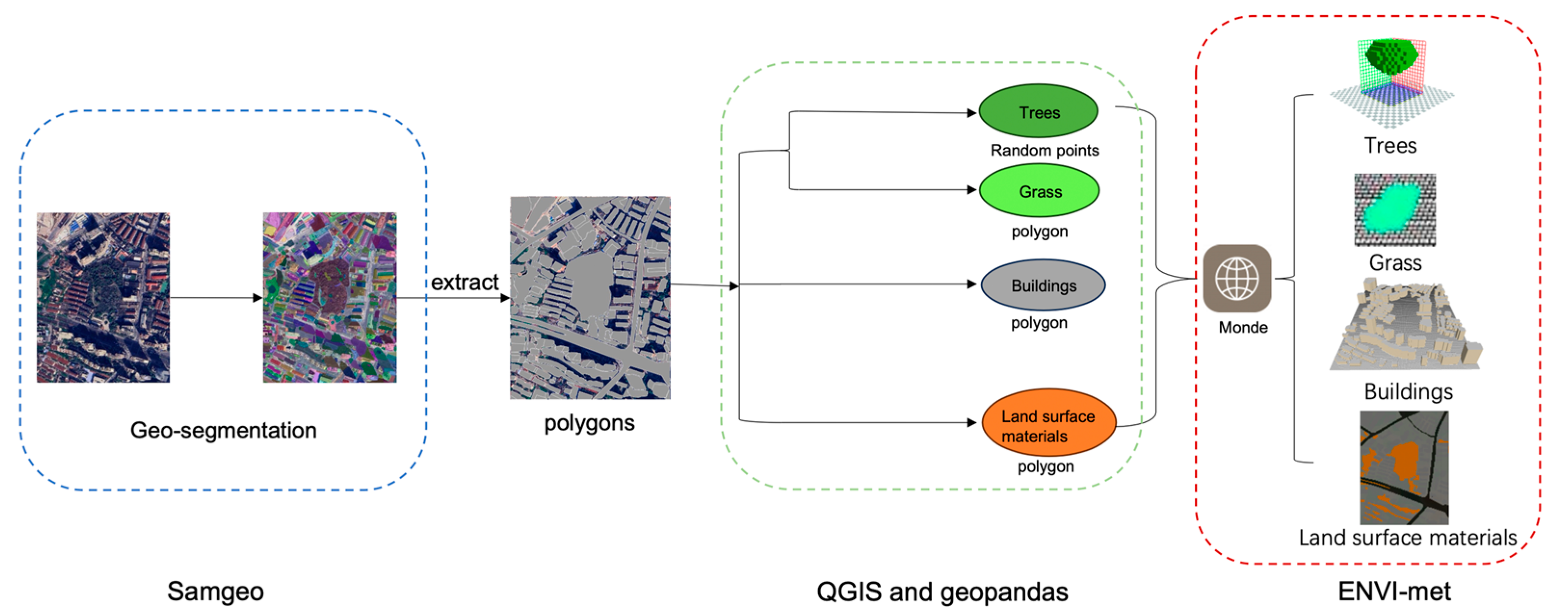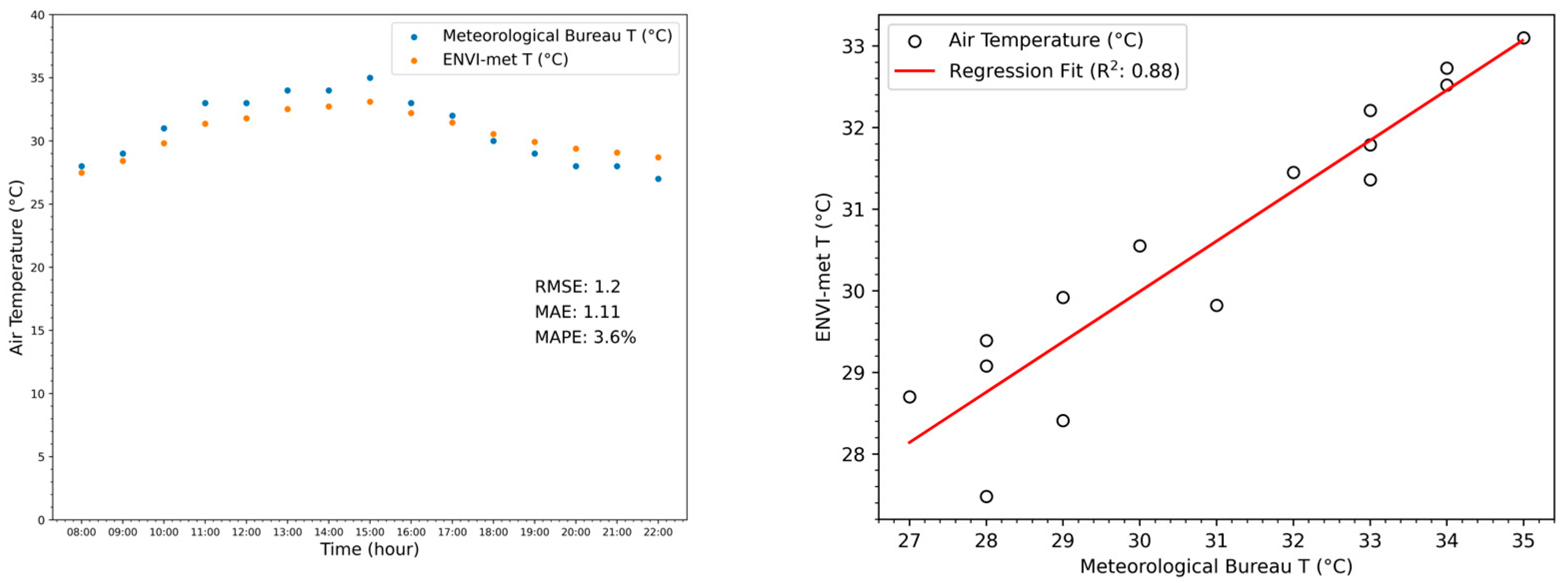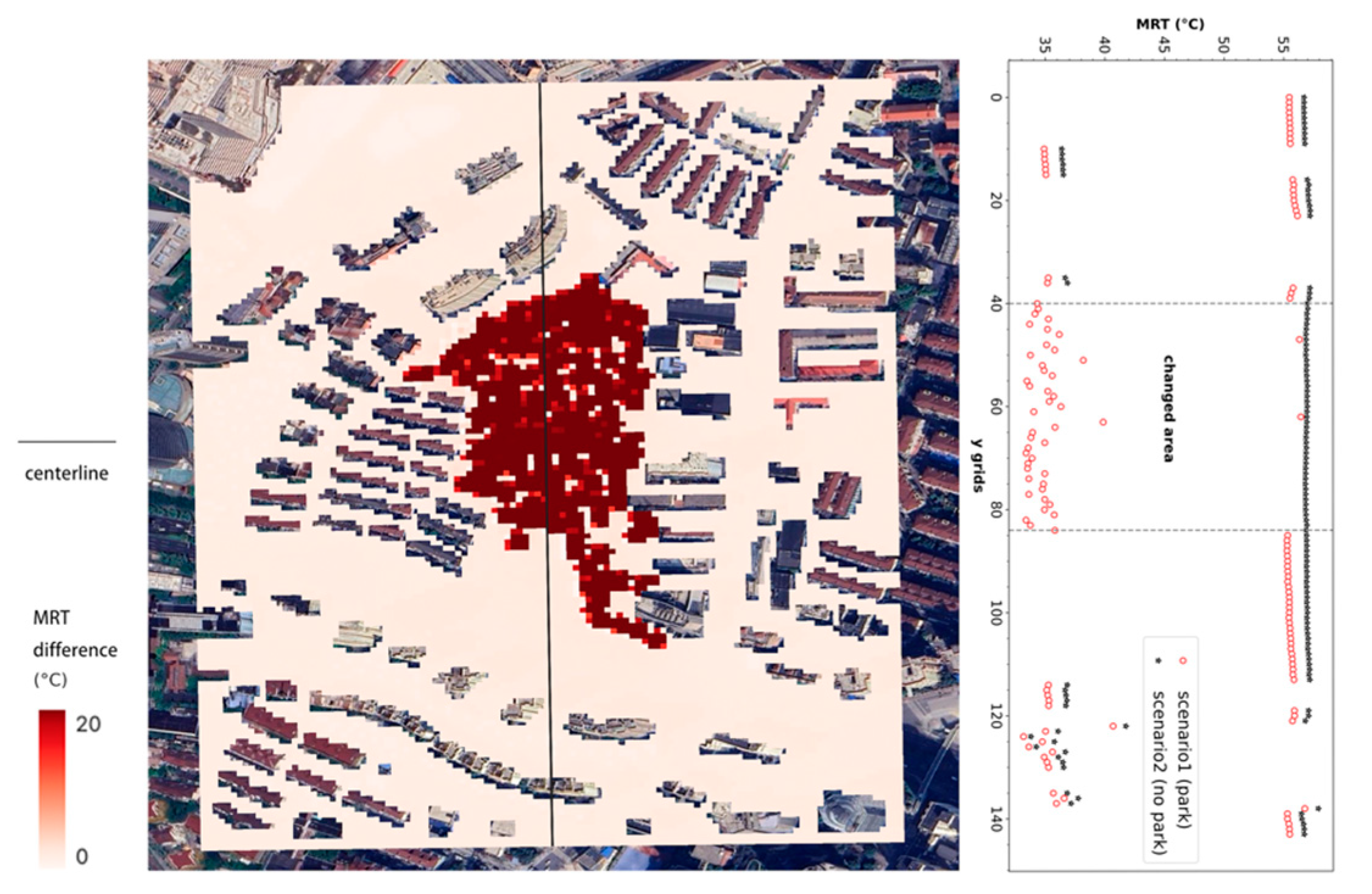Combining Multi-Source Satellite Data with a Microclimate Model to Analyze the Microclimate of an Urban Park
Abstract
1. Introduction
- The fact that vector files for roads, buildings, etc., are usually sourced from government data or OpenStreetMap leads to data insufficiencies in certain areas.
- The existing land surface material data are challenged by insufficient spatial resolution at the scale of urban parks. This limitation hampers accurate modeling and analysis and therefore requires more refined data sources to enhance the quality of environmental simulations.
- Parameter data in ENVI-met studies come mainly from field observations, which are susceptible to external influences.
2. Study Area
3. Data and Methods
3.1. Area Input: Land Surface Material and Buildings
3.2. Parameter Input: Weather and Soil Temperature/Moisture Data
3.2.1. Weather Data
3.2.2. Soil Temperature and Moisture
4. Results and Analysis
4.1. Simulation Accuracy Evaluation
4.2. Results of Analysis
5. Discussion
- (1)
- Using Samgeo for image segmentation of Google Maps: Compared to traditional ENVI-met modeling methods, this approach significantly reduced the time required for manual map drawing in the absence of existing vector data and increased the flexibility of handling geographic geometric data.
- (2)
- Using global soil datasets such as NASA GLDAS-2 and NASA SMAP: These datasets provided excellent temporal continuity and data integrity, effectively reflecting the overall soil conditions of the study area. When field observations are challenging, these datasets can serve as model inputs, leading to relatively accurate simulation results.
- (3)
- To consider the applicability to the general population, the simulation data at a vertical height of 1.4 m were analyzed via horizontal and longitudinal slicing. The results indicated that, compared to the assumed asphalt road scenario, the real park provided a cooling effect because of tree shading and increased the relative humidity of the air because of plant transpiration. In addition, the vegetation in the park increased surface friction and thereby significantly reduced the wind speed and suppressed the northward flow of hot air. In contrast, the high-rise buildings in the southern part of the study area formed a barrier-like structure that trapped the hot air and created a “mini heat island”.
6. Conclusions
Author Contributions
Funding
Data Availability Statement
Acknowledgments
Conflicts of Interest
References
- Gago, E.J.; Roldan, J.; Pacheco-Torres, R.; Ordóñez, J. The city and urban heat islands: A review of strategies to mitigate adverse effects. Renew. Sustain. Energy Rev. 2013, 25, 749–758. [Google Scholar] [CrossRef]
- Rizwan, A.M.; Dennis, L.Y.; Chunho, L.I.U. A review on the generation, determination and mitigation of Urban Heat Island. J. Environ. Sci. 2008, 20, 120–128. [Google Scholar] [CrossRef] [PubMed]
- He, J.F.; Liu, J.Y.; Zhuang, D.F.; Zhang, W.; Liu, M.L. Assessing the effect of land use/land cover change on the change of urban heat island intensity. Theor. Appl. Climatol. 2007, 90, 217–226. [Google Scholar] [CrossRef]
- Ogashawara, I.; Bastos, V.D.S.B. A quantitative approach for analyzing the relationship between urban heat islands and land cover. Remote Sens. 2012, 4, 3596–3618. [Google Scholar] [CrossRef]
- Ravanelli, R.; Nascetti, A.; Cirigliano, R.V.; Di Rico, C.; Leuzzi, G.; Monti, P.; Crespi, M. Monitoring the impact of land cover change on surface urban heat island through Google Earth Engine: Proposal of a global methodology, first applications and problems. Remote Sens. 2018, 10, 1488. [Google Scholar] [CrossRef]
- Hirano, Y.; Ichinose, T.; Ohashi, Y.; Shiraki, Y.; Onishi, A.; Yoshida, Y. Simulation of urban surface temperature and surface heat balance in the Tokyo metropolitan area. Sustain. Cities Soc. 2024, 112, 105596. [Google Scholar] [CrossRef]
- Bruse, M.; Fleer, H. Simulating surface–plant–air interactions inside urban environments with a three dimensional numerical model. Environ. Model. Softw. 1998, 13, 373–384. [Google Scholar] [CrossRef]
- Middel, A.; Häb, K.; Brazel, A.J.; Martin, C.A.; Guhathakurta, S. Impact of urban form and design on mid-afternoon microclimate in Phoenix Local Climate Zones. Landsc. Urban Plan. 2014, 122, 16–28. [Google Scholar] [CrossRef]
- Ren, J.; Yang, J.; Zhang, Y.; Xiao, X.; Xia, J.C.; Li, X.; Wang, S. Exploring thermal comfort of urban buildings based on local climate zones. J. Clean. Prod. 2022, 340, 130744. [Google Scholar] [CrossRef]
- Kotharkar, R.; Dongarsane, P. Investigating outdoor thermal comfort variations across Local Climate Zones in Nagpur, India, using ENVI-met. Build. Environ. 2024, 249, 111122. [Google Scholar] [CrossRef]
- Heldens, W.; Heiden, U.; Esch, T.; Mueller, A.; Dech, S. Integration of remote sensing based surface information into a three-dimensional microclimate model. ISPRS J. Photogramm. Remote Sens. 2017, 125, 106–124. [Google Scholar] [CrossRef]
- Ensari, E.; Kobaş, B. Web scraping and mapping urban data to support urban design decisions. A|Z ITU J. Fac. Archit. 2018, 15, 5–21. [Google Scholar] [CrossRef]
- Cilek, M.U.; Cilek, A. Analyses of land surface temperature (LST) variability among local climate zones (LCZs) comparing Landsat-8 and ENVI-met model data. Sustain. Cities Soc. 2021, 69, 102877. [Google Scholar] [CrossRef]
- Shi, L.; Ling, F. Local climate zone mapping using multi-source free available datasets on google earth engine platform. Land 2021, 10, 454. [Google Scholar] [CrossRef]
- Sigler, L.; Gilabert, J.; Villalba, G. Exploring methods for developing local climate zones to support climate research. Climate 2022, 10, 109. [Google Scholar] [CrossRef]
- Song, B.; Kim, S.H.; Park, G.; Park, K. Comparison of urban physical environments and thermal properties extracted from unmanned aerial vehicle images and ENVI-met model simulations. Build. Environ. 2024, 261, 111705. [Google Scholar] [CrossRef]
- Reichle, R.; De Lannoy, G.; Koster, R.D.; Crow, W.T.; Kimball, J.S.; Liu, Q.; Bechtold, M. SMAP L4 Global 3-Hourly 9 km EASE-Grid Surface and Root Zone Soil Moisture Analysis Update, Version 7; data set; NASA National Snow and Ice Data Center Distributed Active Archive Center: Boulder, CO, USA, 2022. [Google Scholar]
- Rodell, M.; Houser, P.R.; Jambor, U.E.; Gottschalck, J.; Mitchell, K.; Meng, C.J.; Arsenault, K.; Cosgrove, B.; Radakovich, J.; Bosilovich, M.; et al. The global land data assimilation system. Bull. Am. Meteorol. Soc. 2004, 85, 381–394. [Google Scholar] [CrossRef]
- Cruz, J.A.; Blanco, A.C.; Garcia, J.J.; Santos, J.A.; Moscoso, A.D. Evaluation of the cooling effect of green and blue spaces on urban microclimate through numerical simulation: A case study of Iloilo River Esplanade, Philippines. Sustain. Cities Soc. 2021, 74, 103184. [Google Scholar] [CrossRef]
- Junjie, R. Effect of Urban Parks on Thermal Environment in Summer: A Case Study in Shanghai. Ecol. Environ. Sci. 2016, 25, 1663–1670. [Google Scholar]
- Yang, J.; Huang, X. The 30 m annual land cover dataset and its dynamics in China from 1990 to 2019. Earth Syst. Sci. Data 2021, 13, 3907–3925. [Google Scholar] [CrossRef]
- Zanaga, D.; Van De Kerchove, R.; De Keersmaecker, W.; Souverijns, N.; Brockmann, C.; Quast, R.; Wevers, J.; Grosu, A.; Paccini, A.; Vergnaud, S.; et al. ESA WorldCover 10 m 2020 v100. Zenodo 2021. [Google Scholar] [CrossRef]
- Wu, Q.; Osco, L. samgeo: A Python package for segmenting geospatial data with the Segment Anything Model (SAM). J. Open Source Softw. 2023, 8, 5663. [Google Scholar] [CrossRef]
- Osco, L.P.; Wu, Q.; de Lemos, E.L.; Gonçalves, W.N.; Ramos, A.P.M.; Li, J.; Junior, J.M. The Segment Anything Model (SAM) for remote sensing applications: From zero to one shot. Int. J. Appl. Earth Obs. Geoinf. 2023, 124, 103540. [Google Scholar] [CrossRef]
- Trujillano, F.; Jimenez, G.; Manrique, E.; Kahamba, N.F.; Okumu, F.; Apollinaire, N.; Carrasco-Escobar, G.; Barrett, B.; Fornace, K. Using image segmentation models to analyse high-resolution earth observation data: New tools to monitor disease risks in changing environments. Int. J. Health Geogr. 2024, 23, 13. [Google Scholar] [CrossRef]
- Chen, Y.; Wang, C.; Hu, Y. Energy Consumption and Outdoor Thermal Comfort Characteristics in High-Density Urban Areas Based on Local Climate Zone—A Case Study of Changsha, China. Sustainability 2024, 16, 7157. [Google Scholar] [CrossRef]
- Salata, F.; Golasi, I.; de Lieto Vollaro, R.; de Lieto Vollaro, A. Urban microclimate and outdoor thermal comfort. A proper procedure to fit ENVI-met simulation outputs to experimental data. Sustain. Cities Soc. 2016, 26, 318–343. [Google Scholar] [CrossRef]
- Yang, J.; Hu, X.; Feng, H.; Marvin, S. Verifying an ENVI-met simulation of the thermal environment of Yanzhong Square Park in Shanghai. Urban For. Urban Green. 2021, 66, 127384. [Google Scholar] [CrossRef]
- Gorelick, N.; Hancher, M.; Dixon, M.; Ilyushchenko, S.; Thau, D.; Moore, R. Google Earth Engine: Planetary-scale geospatial analysis for everyone. Remote Sens. Environ. 2017, 202, 18–27. [Google Scholar] [CrossRef]
- Amani, M.; Ghorbanian, A.; Ahmadi, S.A.; Kakooei, M.; Moghimi, A.; Mirmazloumi, S.M.; Moghaddam, S.H.; Mahdavi, S.; Ghahremanloo, M.; Parsian, S.; et al. Google earth engine cloud computing platform for remote sensing big data applications: A comprehensive review. IEEE J. Sel. Top. Appl. Earth Obs. Remote Sens. 2020, 13, 5326–5350. [Google Scholar] [CrossRef]
- Zhao, Q.; Yu, L.; Li, X.; Peng, D.; Zhang, Y.; Gong, P. Progress and trends in the application of Google Earth and Google Earth Engine. Remote Sens. 2021, 13, 3778. [Google Scholar] [CrossRef]
- Stunder, M.; Sethuraman, S. A statistical evaluation and comparison of coastal point source dispersion models. Atmos. Environ. 1986, 20, 301–315. [Google Scholar] [CrossRef]
- Chatterjee, S.; Khan, A.; Dinda, A.; Mithun, S.; Khatun, R.; Akbari, H.; Kusaka, H.; Mitra, C.; Bhatti, S.S.; Van Doan, Q.; et al. Simulating micro-scale thermal interactions in different building environments for mitigating urban heat islands. Sci. Total Environ. 2019, 663, 610–631. [Google Scholar] [CrossRef] [PubMed]
- Yilmaz, S.; Külekçi, E.A.; Mutlu, B.E.; Sezen, I. Analysis of winter thermal comfort conditions: Street scenarios using ENVI-met model. Environ. Sci. Pollut. Res. 2021, 28, 63837–63859. [Google Scholar] [CrossRef] [PubMed]
- Lai, Y.; Ning, Q.; Ge, X.; Fan, S. Thermal regulation of coastal urban forest based on Envi-Met Model—A case study in Qinhuangdao, China. Sustainability 2022, 14, 7337. [Google Scholar] [CrossRef]
- Abuzaid, A.S.; El-Komy, M.S.; Shokr, M.S.; El Baroudy, A.A.; Mohamed, E.S.; Rebouh, N.Y.; Abdel-Hai, M.S. Predicting Dynamics of Soil Salinity and Sodicity Using Remote Sensing Techniques: A Landscape-Scale Assessment in the Northeastern Egypt. Sustainability 2023, 15, 9440. [Google Scholar] [CrossRef]
- Vivas, E.; Allende-Cid, H.; Salas, R. A systematic review of statistical and machine learning methods for electrical power forecasting with reported mape score. Entropy 2020, 22, 1412. [Google Scholar] [CrossRef]











| Category | Type | Description | Code |
|---|---|---|---|
| Building | Polygon | Heavy concrete wall | 000C1 |
| Land Surface Material | Polygon | Asphalt road | 0100ST |
| Polygon | Artificial pavement | 0000PD | |
| Polygon | Natural pavement | 000000 | |
| Vegetation | Point | Heart-shaped, large trunk, dense, medium (15 m) | 01HLDM |
| Polygon | 25 cm height grass | 0100xx |
| Parameters | Values Used | |
|---|---|---|
| Simulation date | 7 September 2022 | |
| Simulation time | 8:00 a.m.–10:00 p.m. | |
| Total simulation hours | 14 h | |
| Resolution (x, y, z) | 5,5,2 m | |
| Grid (x,y,z) | 113,144,90 | |
| Wind speed | 3 m/s | |
| Wind direction | 180 | |
| Cloud cover | 0 | |
| Specific humidity in 2500 m (g/kg) | 8.00 | |
| Roughness length | 0.01 | |
| Initial air temperature range | 23–35 °C | |
| Initial relative humidity range | 39.04–94.15% | |
| Temperature of soil level | (0–20 cm) | 26.67 °C |
| (20–50 cm) | 25.8 °C | |
| (50–200 cm) | 25.4 °C | |
| (>200 cm) | 24.96 °C | |
| Soil moisture | 19.5% | |
Disclaimer/Publisher’s Note: The statements, opinions and data contained in all publications are solely those of the individual author(s) and contributor(s) and not of MDPI and/or the editor(s). MDPI and/or the editor(s) disclaim responsibility for any injury to people or property resulting from any ideas, methods, instructions or products referred to in the content. |
© 2024 by the authors. Licensee MDPI, Basel, Switzerland. This article is an open access article distributed under the terms and conditions of the Creative Commons Attribution (CC BY) license (https://creativecommons.org/licenses/by/4.0/).
Share and Cite
Pan, Y.; Morimoto, T.; Ichinose, T. Combining Multi-Source Satellite Data with a Microclimate Model to Analyze the Microclimate of an Urban Park. Climate 2024, 12, 197. https://doi.org/10.3390/cli12120197
Pan Y, Morimoto T, Ichinose T. Combining Multi-Source Satellite Data with a Microclimate Model to Analyze the Microclimate of an Urban Park. Climate. 2024; 12(12):197. https://doi.org/10.3390/cli12120197
Chicago/Turabian StylePan, Yi, Takehiro Morimoto, and Toshiaki Ichinose. 2024. "Combining Multi-Source Satellite Data with a Microclimate Model to Analyze the Microclimate of an Urban Park" Climate 12, no. 12: 197. https://doi.org/10.3390/cli12120197
APA StylePan, Y., Morimoto, T., & Ichinose, T. (2024). Combining Multi-Source Satellite Data with a Microclimate Model to Analyze the Microclimate of an Urban Park. Climate, 12(12), 197. https://doi.org/10.3390/cli12120197







